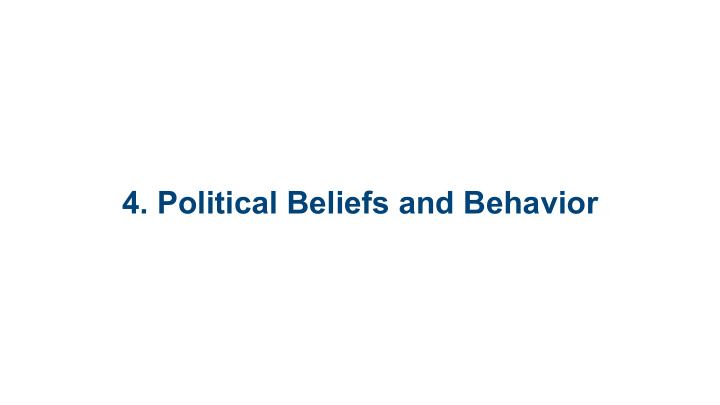



4. Political Beliefs and Behavior
4.1 Processes By Which Citizens Learn About Politics 4.2 Political Participation 4.3 Public Opinion
4.4 Beliefs That Citizens Hold About Governments and Its Leaders 4.5 Political Culture 4.6 The Influence of Public Opinion on Political Leaders
4.1. Processes By Which Citizens Learn About Politics
Mass Media Religious Institutions Schools Workplace Community
Some political cultures stress citizen involvement Others try to exclude participation by the masses
4.2. Political Participation
USCIS citizenship requirements: 1. Reside in the U.S. 2. Speak, read, write English 3. “Favorable disposition”
4. Commitment to Constitution 5. Knowledge of American government!
Voting Factors: • Education • Income • Socioeconomic status • Age • Political party affiliation
Party affliction affected by generation • Millennials tend to be Democrats • Baby Boomers tend to be Republican
Party affliction affected by region North more industrialized South more agrarian
Most significant influence is the individual’s family Party identification does not change much from youth
The “normal vote” predicts the number of votes Democratic and Republican candidates will receive. Candidates can then predict where to concentrate their resources.
Sociotropic voters Valence issues Issue salience Self-interest principle And some people don’t vote based on issues at all … .
Name recognition also influences vote • Eddie Murphy
4.3. Public Opinion
Beliefs – closely held ideas that support values & expectations about life & politics Attitudes – the preferences we form based on our experiences & values Beliefs and attitudes form opinions that can be measured.
Theory of polling: Random selection Size of poll Variation
Types of opinion: Consensus Divided Bimodal Normal distribution Table distribution
4.4. Beliefs That Citizens Hold About Government and Its Leaders
Ideology changes more quickly than beliefs and values. Most Americans do not identify with a particular ideology. If they do, it is usually either Conservatism or Liberalism.
Fascism Authoritarianism
Capitalism: the people acquire wealth and keep the proceeds of their work (U.S.) Communism: common ownership of property and production controlled by the government (former U.S.S.R.)
U.S. citizens have become less trusting of governmental institutions
4.5 Political Culture
Political culture can be defined as the shared attitudes of a people regarding a government
Political socialization The processes by which we are trained to understand and join a country’s political world Primary principles Structuring principles
Diffuse support • High level of stability in politics • Acceptance of the government as legitimate • Common goal of preserving the system
Why don’t people vote? Elite theory Low political efficacy Decline in social capital Rational choice theory
4.6. The Influence of Public Opinion on Political Leaders
Horserace coverage – The media calls out the candidate’s every move Bandwagon effect – the media pays attention to candidates who poll well early … which gives those candidates momentum
The correlation between polling & elections is clearer than the correlation between polling & government officials.
Exit polls – are the last polls taken by the media Controversial … do they convince people to stay home?
Recommend
More recommend